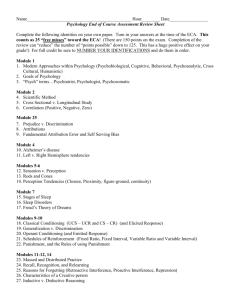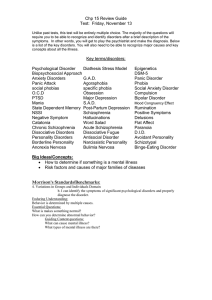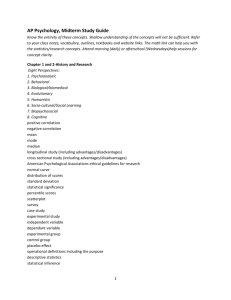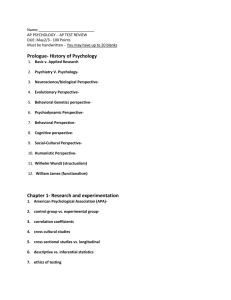UNIT 3 Theories of Learning, Memory, and
advertisement
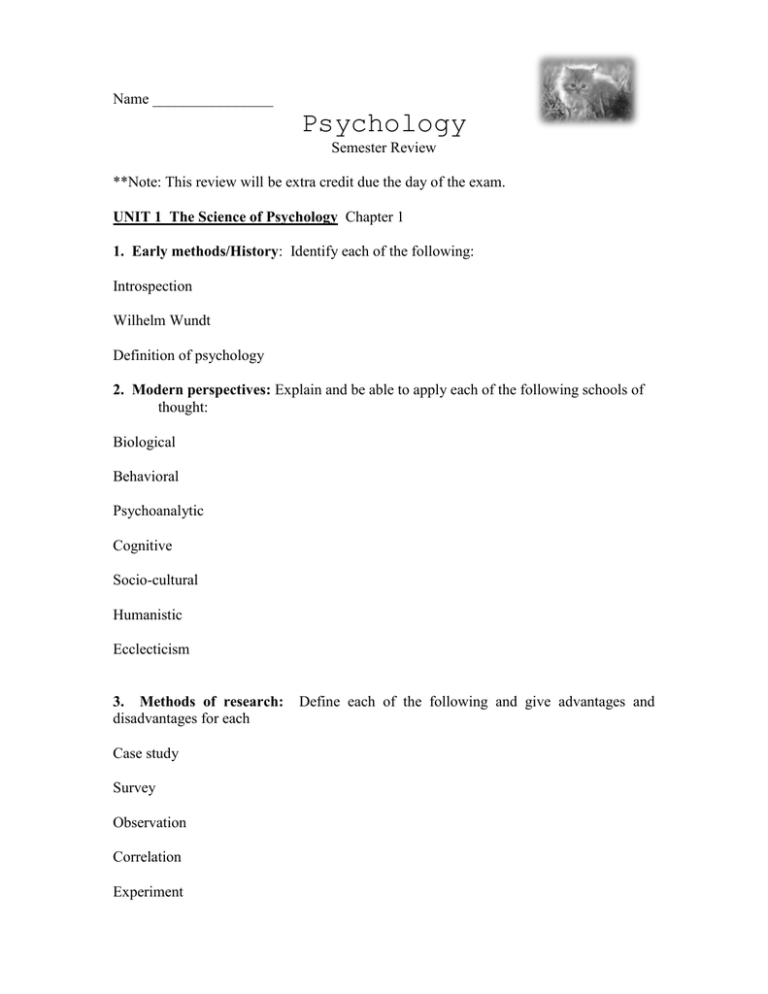
Name ________________ Psychology Semester Review **Note: This review will be extra credit due the day of the exam. UNIT 1 The Science of Psychology Chapter 1 1. Early methods/History: Identify each of the following: Introspection Wilhelm Wundt Definition of psychology 2. Modern perspectives: Explain and be able to apply each of the following schools of thought: Biological Behavioral Psychoanalytic Cognitive Socio-cultural Humanistic Ecclecticism 3. Methods of research: disadvantages for each Case study Survey Observation Correlation Experiment Define each of the following and give advantages and 4. Experimental method: Define each of the following terms relating to experimental Design: Hypothesis Dependent variable Independent variable Control group Experimental group Confounding variables Placebo What are the requirements for good experimental design? What are some considerations in experimental ethics? 5. A psychologist believes lithium can be effective in treating depression. To study this, he puts all of his depressed patients into two groups. One group gets lithium to treat their depression, and the other group does not. He then follows the progress of each group to see how many people in each group recover. Identify each of the following parts in this experiment: Hypothesis: Control group: Experimental group: Independent variable: Dependent variable: 2 confounding variables: Unit 2 The Brain, Sensation and Perception Chapters 3 & 4 Neural and Hormonal Systems (Module7) 6. Define: a. Neuron b. Synapse c. Neurotransmitter d. Dendrite 7. What are endorphins? 8. Describe the difference between the Central and Peripheral Nervous systems. What 2 parts is each divided into? 9. Define endocrine system. 10. Describe the functions of the pituitary and adrenal glands The Brain (Module 8) 11. Describe the functions of each of the following brain parts: a. cerebellum b. hypothalamus c. frontal lobe d. reticular formation e. corpus callosum 12. Where in the brain is the visual area located? 13. What is the difference between right and left brain dominant? 14. Which side of the brain controls which side of the body? Sensation (Module 9) 15. What is the difference between sensation and perception? 16. Explain the functions of the rods and cones 17. Define selective attention Perception (Module 10) 18. Define illusion 19. Name and describe 4 other cues that create depth perception. UNIT 3 Theories of Learning, Memory, and Intelligence Chapters 7, 8, & 10 Memory (Module 18) 20. Define sensory, short term, and long term memory 21. Name the 3 steps in the Memory process (hint: NOT the same as above) 22. Define chunking, mnemonic device Intelligence (Module 24) 23. Would it be more accurate to describe intelligence as knowledge or ability? 24. Describe Howard Gardner’s Multiple intelligence theory 25. What is the formula for figuring IQ? What is average IQ? 26. What is the relationship between intelligence and heredity? Classical Conditioning (Module 15) 27. Define learning 28. Explain the difference between Classical and Operant conditioning 29. Who was the scientist associated with classical conditioning? Describe his famous experiment and be able to label the parts. 30. It is natural for students to gather notebooks, folders,etc. when the bell rings to end a class. Students with 2nd period class often become conditioned to respond to a different signal that class is over. At 8:59 the clocks buzz a minute before the bell rings. Since this happens everyday, it doesn’t take long before students begin gathering their materials when the clock buzzes. This is an example of __________ conditioning. Identify: UCS: CS: UCR: CR: 31. Define generalization, discrimination, extinction Operant conditioning (Module 16) 32. Ed is an autistic child. He seldom will look at anyone. In an attempt to get him to look at them, his parents will say loudly, “Ed look at me!” If Ed looks at them, the parents give him a cookie and praise. This is an example of ___________ conditioning. If Ed looks only at the mother, and doesn’t respond to the father, then what process has occurred? If Ed eventually looks at everyone, what process has occurred? If Ed’s parents stopped giving him cookies, and after awhile, he stopped looking at them, what process has occurred? 33. Define operant conditioning. Who was the scientist associated with this theory? 34. Define reinforcement and punishment 35. Define positive and negative reinforcement 36. Describe each of the following reinforcement schedules, and the strength of their effect on behavior: Variable ratio Variable interval Fixed ratio Fixed interval Other types of learning (Module 17) 37. Define observational learning and describe Bandura’s famous experiment. UNIT 4 Personality Chapter 11 38. Define Personality 39. Who was responsible for Psychoanalytic theory? 40. Describe Freud’s theory of the Id, Ego, and Superego 41. Describe Freud’s childhood stages and the problems he associated with each 42. Who were the 2 main humanists and what were their theories? 43. Describe each of the following personality theories and give examples: Trait theory Psychoanalytic theory Social Cognitive 44. Define the following defense mechanisms: Rationalization Regression Displacement Projection Repression UNIT 5 Psychological disorders and treatment Chapters 12 & 13 Psychological Disorders (module 27) 45. What are the 4 criteria psychologist use to determine if a person’s behavior is disorder? Be able to define and apply. 46. What is the DSM-IV? Anxiety and Mood Disorders (Module28) 47. Define each of the following: Agoraphobia Panic disorder Specific phobia Social phobia Obsessive-compulsive disorder Post-traumatic stress disorder 48. Know the difference between obsessions and compulsions, be able to give examples 49. Name and define the 4 types of mood disorders 50. Name at least 3 symptoms of depression 51. Name at least 3 symptoms of mania 52. Name the chemical neurotransmitter linked to depression 53. Depressed people tend to explain bad events as __________, __________, and ___________? Dissociative, Schizophrenia, and Personality Disorders (Module 29) 54. Name and define the 4 types of Dissociative disorders. 55. What are the 3 symptoms dissociative disorders share in common? (Loss of……) 56. What is probably the main cause of dissociative identity disorder? 57. What are the 4 positive symptoms of schizophrenia? 58. What are the 4 negative symptoms? 59. What is the chemical neurotransmitter linked to Schizophrenia? 60. Define: Flat affect Hallucination Delusion 61. Define Personality disorder 62. Define each of the following personality disorders: Antisocial Borderline Therapy (Module 30) 63. What would be the focus of psychoanalytic therapy? 64. What is systematic desensitization and what would it be used to treat? Which perspective does this treatment fall under? 65. Describe cognitive therapy for depression. 66. Name some biological treatments.
